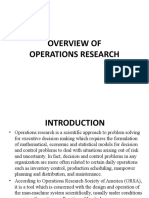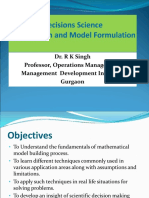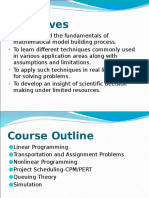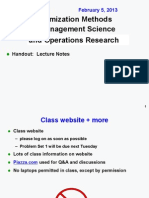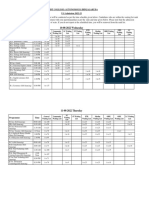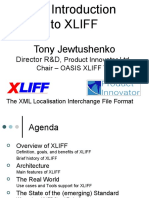Management Science Theory Short Notes (1)
Uploaded by
Suhail MohammedManagement Science Theory Short Notes (1)
Uploaded by
Suhail MohammedlOMoARcPSD|29609139
Management Science- theory short notes
Management Science (University of Calicut)
Scan to open on Studocu
Studocu is not sponsored or endorsed by any college or university
Downloaded by Suhail Mohammed ([email protected])
lOMoARcPSD|29609139
Management Science (BBA)
Module I (Operation research)
Operations research
According to T.L Salty “Operations research is the art of giving bad
answer to the problems where otherwise worse answers are given.”
Characteristics/ features of OR
It is a continues process
It facilitate decision making
It is the science of optimization
System orientation approach
It provide quantitative base for analyzing problem
It uses scientific methods for decision making
Functions/ Importance of OR
1. It is multidisciplinary
2. It is used to solve complex problems
3. It provides solution to various business problems
4. It facilitate the process of decision making
5. Optimum allocation of limited resources
6. Planning, scheduling, controlling large and complex projects
Scope and objectives of OR
Defense operations
Industry
Agriculture
Traffic control
Hospitals
Planning
Research and development
Operations research and modern business management
Operations research tools are used in the following areas:
Finance budgeting and investment
Purchasing and procurement
Production management
Downloaded by Suhail Mohammed ([email protected])
lOMoARcPSD|29609139
Personal management
Research and development
Phases of OR
1. Formulation of problem
2. Set up mathematical model for problem
3. Deriving solution from the model
4. Testing the model
5. Establishing control over the model
6. Implementing the solution
Operation Research Models
1. Physical model (Iconic model)
It is a type of model includes all form of diagrams, graphs and charts.
They are designed to deal with specific problems.
2. Mathematical model (Symbolic model)
It is a type of model which consists of a set of equations which defines
the relationship and interaction among various element of a decision
problem under study.
3. Analogue model (Schematic model)
It is a type of model which represent the existing relationship between
various members of the organisation.
4. Analytical model
Mathematical tools are used to solve a problem.
5. Simulation and heuristic model
It is a trial and error approach method to find out optimum solution.
Operation Research Techniques
Probability
It simply means chance of happening or non-happening of an event.
Decision Theory
It is a set of quantitative methods for reaching optimal decisions. It is
concerned with how to assist people or organization in making
decisions.
Downloaded by Suhail Mohammed ([email protected])
lOMoARcPSD|29609139
Game theory
Game theory is the branch of decision theory concerned with
independent decisions. It deals with competitive situation of decision
making under uncertainty.
Linear programming
Linear programming is a quantitative tool for optimal allocation of
limited resources among competing activities.
Transportation problem
Transportation problem is a special type of linear programming problem.
It typically involves situation where goods are required to be transferred
from sources to some destination.
Assignment problem
It is a particular case of transportation problem where the objective is to
assign a number of resources to an equal number of activities to
minimize total cost or maximize total profit of allocation.
Dynamic programming
This technique deals with the problems that arises in connection with
multi period analysis and decisions.
Sequencing
It is an operation research technique which determines a sequence in
which given job should be performed.
Queuing theory
Queuing theory or waiting line theory deals with analysis of queues and
queuing behavior.
Network analysis
Network analysis refers to number of techniques for the planning and
control of the complex projects.
Simulations
It is a numerical solution method which helps to analyses a system to find
it is optimum solution through trial and error approach.
Downloaded by Suhail Mohammed ([email protected])
lOMoARcPSD|29609139
Replacement theory
This theory suggested that determination of time when items of plant
should be replaced.
Non-linear programming
It is a form of programming in which some or all the variables are
curvilinear.
Goal programming
It is a technique deals with the problem having multiple objectives.
Probabilistic programming
It refers to linear programming that includes an evaluation of relative risk
and uncertainties in various alternatives of choice for managerial
decisions. It is also known as stochastic programming.
Markov analysis
It is a method of analyzing the current movement of the same variable
in an effort to predict the future movement of the same variable.
Limitations of OR
Non-consideration of intangible factors
Costly
Difficulty in implementation
Difficulty in selection of techniques
Not a substitute for management
Dependence on electronic computer
Distance between manager and operation researcher
Module II (Linear programming)
Linear programming
Linear programming is a quantitative tool for optimal allocation of
limited resources among competing activities.
Objectives of linear programming
1. To maximize profit
2. To minimize cost
Downloaded by Suhail Mohammed ([email protected])
lOMoARcPSD|29609139
Applications of linear programming
Applications in industry Applications in management
Product mix problem Portfolio selection
Product scheduling Profit planning
Product smoothening Media selection
Blending problem Travelling salesman problem
Transportation problem Staffing problem
Merits/ Advantages of linear programming (LPP)
1. It helps to study information through scientific approach.
2. It helps to select the best optimal solution.
3. It improves decision quality.
4. It helps to identify constraints under which an organisation operates.
5. It highlights the bottlenecks in the production process.
6. It helps to indicate the best use of existing facilities.
Limitations of linear programming
1. It can only be applied if constraints and objectives are linear.
2. It is not easy to determine objective functions mathematically in LPP.
3. Large scale problems cannot always be solved.
4. It does not consider uncertainty and time effect.
5. It is a complicated and time consuming technique.
6. It deals with only one objective.
Assumptions of linear programming
Linearity
Finiteness
Additivity
Certainty
Divisibility
Deterministic
Basic requirements of linear programming
1. Well defined objective function
2. Constraints
3. Decision variable and their relationship
Downloaded by Suhail Mohammed ([email protected])
lOMoARcPSD|29609139
4. Alternative course of action
5. Non-negative restrictions
Constraints
Constraints are the restrictions or limitations on the decision variable.
They usually limit the value of decision variables.
Feasible region
The common region determined by all the constraints including non-
negative constraints x, y≥ 0 of a linear programming is called feasible
region.
Module III (Network analysis)
Network analysis
Network analysis refers to number of techniques for the planning and
control of the complex projects.
Objectives/ Advantages/ Importance of network analysis
1. It is a tool for planning, scheduling and control of projects.
2. It shows simple way of inter-relationship among variables.
3. It minimize the total cost.
4. It helps to minimize time of completion of project.
5. It helps to minimize time for a cost.
6. It leads to optimum use of resources.
7. It avoids production delays and conflicts.
8. It facilitate management by exception.
9. It provide comprehensive idea of the project.
10. It helps to minimize cost for a given total time.
Managerial applications of network technique
Planning
Research and development
Marketing strategies
Preparing inventory plans
Assembly line scheduling
Market penetration programs
Development and launching of new products
Downloaded by Suhail Mohammed ([email protected])
lOMoARcPSD|29609139
Construction of building, bridge etc.
Installation of a complex new equipment
Network
It is a series of related activities which results in some product or
services.
Network diagram
It is a diagram which represent activities and events of a network and
its relationship.
Activity
It is the element of job or task or item of work to be completed in a
specific time period.
Types of activities
1. Predecessor activities
An activity which must be completed before one or more other activity
starts.
2. Successor activity
An activity which cannot be started until one or more of the other
activities are completed.
3. Dummy activity
Any activity which does not consume either any resource or time is
called dummy activity.
Events
An event represents start or end of an activity. It is commonly
represented by circles in the network diagram.
Types of events
1. Merge event
An event which represent the joint completion of more than one
activity is called merge event.
2. Burst event
An event which represent the initiation or beginning of more than one
activity is known as burst event.
Guidelines for construction of network diagram
Each activity is represented by only one arrow.
Downloaded by Suhail Mohammed ([email protected])
lOMoARcPSD|29609139
No two activities with same start and end events.
All activities preceding an activity to be completed in all respects.
The length of arrow has no significance in network.
The diagram should flow from left to right.
Arrows should not be crosses.
Arrows should be straight.
Angle between arrows should be large as possible.
Every activity should have a tail and head event.
Dangling should be avoided.
Looping is to be avoided.
Events must be numbered systematically.
Network Techniques
1. CPM
2. PERT
Critical path method (CPM)
It is a network technique involve in the preparation of network in the
form of arrow diagram. It is analyzed to locate critical path.
Terms related to CPM
Path
It refers to unbroken chain of activity from start event to end event in
the network diagram.
Critical path
It is the continuous chain of critical activities in a network diagram
Critical activities
Activities lying on the critical path are called critical activities.
Length of the critical path
It is the sum of the individual times of all critical activities lying on it and
defines the minimum time required to complete the project.
Critical path analysis
It is a type of analysis to estimate total project duration and assign
starting and finishing time to all activities in a project.
Downloaded by Suhail Mohammed ([email protected])
lOMoARcPSD|29609139
Activity time in CPM
Earliest start time (EST)
It is the earliest time at which an activity can start.
Earliest finish time (EFT)
It is the earliest time at which an activity can finish.
Latest start time (LST)
It is the latest time which an activity can be started without delaying the
completion of the project.
Latest finish time (LFT)
It is the latest time by which an activity can be finished without delaying
the completion of project.
Earliest event time
It is the earliest time at which an event can occur without affecting the
total project time.
Latest event time
It is the latest occurrence time of an event without affecting the total
project time.
Steps to determine the critical path
1. Breakdown the project into various activities systematically.
2. Number all the nodes and activities.
3. Mark activity time on arrows.
4. Calculate EST, EFT, LST and LFT and mark this on diagram.
5. Determine the total float for each activity.
6. Locate the critical activities.
7. Connect these critical activities by a double line arrow.
8. Calculate the total project duration.
Slack
Slack is the difference between the latest and the earliest event time.
Total float
Total float may be defined as difference between the latest and earliest
activity time.
Downloaded by Suhail Mohammed ([email protected])
lOMoARcPSD|29609139
Free float
Free float is the amount of time that a schedule activity can be delayed
without delayed without delaying the early start date of any immediate
successor activity within the network path.
Independent float
It is the portion of the total float within which an activity can be delayed
for start without affecting floats of the preceding activities.
Advantages of CPM
1. It helps top management to concentrate on critical activities.
2. It helps to locate critical and non-critical activities.
3. It helps to plan and schedule a project.
4. It inform about duration, size and performance of an activity.
5. It helps to determine actual dates for each activity.
6. It is beneficial to monitoring cash flows.
Limitations of CPM
1. In real practice time of each activity is not known.
2. It does not consider statistical analysis for time estimates.
3. It is only suitable for project with definite start and end.
4. It has limited validity for projects with non-reliable time estimates.
5. Usefulness limited to complex and large scale projects.
Program evaluation and review techniques (PERT)
PERT is a statistical tool used in project management, which was
designed to analyze and represent the task involved in completing a
given project.
Time estimates In PERT
1. Optimistic time estimates
It is the estimate of minimum possible time which an activity will take to
complete with an ideal situation.
2. Most likely time estimate
It refers to the estimate of the normal time that the activity would take.
3. Pessimistic time estimates
It is the maximum time that an activity would take if everything goes
wrong and abnormal situation are prevailed.
Downloaded by Suhail Mohammed ([email protected])
lOMoARcPSD|29609139
Steps in PERT calculation
Locating activities and events of a project.
Based on activities, network diagram drawn.
Number all the events and activities.
Obtain various time estimates for each activity.
Calculate expected time for each activity.
Find out earliest event time and latest event time for each event.
Calculate float associated with each activities.
Add all critical path time estimates.
Find out SD and variance for each activities.
Sum of the variance of time estimates are critical activities.
Calculate standard normal variable Z.
Advantages of PERT
1. It forces management to plan carefully.
2. It concentrates on critical activities of projects.
3. It helps to reduce production delays and conflicts.
4. It provide a forward looking type of control.
5. It provides up to date information.
6. It helps to formulate new schedules.
7. It forces to take right action at right time.
Limitations of PERT
1. It emphasize on time only.
2. Developing a clear and logical network is difficult.
3. It is not suitable for routine planning of recovering events.
4. It doesn’t consider resources required at various stages.
5. There may be errors in time estimation.
6. It is a costly affair.
Similarities of CPM and PERT
Both are network technique.
Both are used as decision making technique.
Critical area and path are found in both techniques.
Both techniques project divided in to different activities.
Downloaded by Suhail Mohammed ([email protected])
lOMoARcPSD|29609139
Network diagram are drawn in both cases.
Difference between CPM and PERT
CPM PERT
It is activity oriented It is event oriented
It is a deterministic model It is a probabilistic model
It used for non-repetitive jobs It used for repetitive jobs
It considers time and cost It considers only time
Dummy activities not necessary It uses dummy activities
It not deals with time uncertainty It deals with time uncertainty
It used for construction problems It used for planning programs
It is not important control device It is an Important control device
Crashing is applicable Crashing is not applicable
Critical path is based on float Critical path is based on slack
Practical application of PERT
1. It is used for construction industry.
2. It is helpful in scheduling government and commercial aircrafts.
3. It is helpful in installing fixed assets and plant layout.
4. It is useful for general administration of firm.
5. It can be used in defends projects.
6. It can be used in research and development project.
Module IV (Decision theory)
Decision theory
It is a set of quantitative methods for reaching optimal decisions. It is
concerned with how to assist people or organization in making
decisions.
Decision making situations
Course of action
These are the acts available to decision makers. These are called as
action, acts or strategies.
State of nature
There is a set of exclusive and exhaustive outcomes consequents to the
decision made. These events are called state of nature.
Downloaded by Suhail Mohammed ([email protected])
lOMoARcPSD|29609139
Pay off
Pay off are the outcomes or events expressed in quantitative terms to
represent cost or profit of a given action consequent to the decisions.
Pay off table
It is also called pay off matrix. This depicts the tabular form of pay off of
various alternative course of action vs state of nature.
Opportunity loss
It is difference between the optimal payoff and the actual payoff
received.
Maximax
It is a decision rule that find the course of action that maximize the
maximum payoff.
Minimax
It is a decision rule for minimizing maximum possible loss.
Risk
It is the potential that a decision will lead to a loss or undesirable
outcome.
Expected monetary value (EMV)
It means how much money which expect to make from a certain
decision.
Expected value of perfect information (EVPI)
It is the expected outcome with perfect information.
Game theory
Game theory is the branch of decision theory concerned with
independent decisions. It deals with competitive situation of decision
making under uncertainty.
Game
Game is an activity between two opposing parties based on a set of
rules.
Elements of a game
1. Players
2. Strategy of each players
3. Pay offs
Downloaded by Suhail Mohammed ([email protected])
lOMoARcPSD|29609139
Features of game
Situation is competitive
There is a finite number of competitors
Each competitor has a finite number of strategies
Every games leads to an outcome
Every outcome has stakes
Assumptions in a game
1. The players act rationally.
2. The players act intelligently.
3. Each players know everything about game
4. The player attempt to maximize gain and minimize losses.
5. All relevant information is known to each other.
6. The player make individual direction without direct communication.
7. The player simultaneously select their course of action.
8. The payoff is fixed and determine in advance.
Basic concept of game theory
Strategy
Strategy is a plan of action conceived and carefully executed by each
party to win over the game.
Types of strategy
a) Pure strategy: It is the predetermined plan of action based on which
games are played which does not change during the game.
b) Mixed strategy: This is the strategy get changed while the game is in
progress.
Optimum strategy
It is a course of action which puts the player in the most preferred
position.
Fair game
Game is said to be fair when the value of outcome is zero.
Saddle point
It is the value of an element in pay off matrix which is the minimum of
its raw as well as maximum of its column.
Downloaded by Suhail Mohammed ([email protected])
lOMoARcPSD|29609139
Two person zero sum game
A two player game is called a zero sum game. If the sum of the payoffs
to each player is constant for all possible outcomes of the game.
Game with saddle points
Suppose there are two players A and B. A game for which maximin for A
is equal to minimax for B is called game with a saddle point.
Value of the game
Payoff saddle point is called the value of the game.
Decision trees
A tree diagram which is used for making decision in business.
Nodes
There are two types of nodes in a decision tree.
a. Decision node (Act node)
Decision nodes are those nodes usually represented by a square. It
indicates where a decision maker must make a decision for selecting
one alternative among available actions.
b. Chance node (Event node)
It is a node represented by a circle. It indicates different possible
outcomes.
Branches
Branches emanate from and connect various nodes are either decision
or states of nature.
Types of branch
Decision branches
It is the branches which leads away from the decision nodes and which
represent a course of action.
Chance branches
It is the branch which leads away from chance nodes and which
represent state of nature.
Terminal branches
A branch which makes the end of the decision tree is called terminal
branch.
Downloaded by Suhail Mohammed ([email protected])
lOMoARcPSD|29609139
Types of decision trees
1. Deterministic decision tree
2. Probabilistic decision tree
Uses / Importance of decision tree
It help to depict multi-dimensional aspect of major decision problem.
It enables to see elements related with problem systematically.
It relates available strategies with network of future events.
It gives attention on critical factors in decision problem.
It helps to present and define complex managerial problems.
It applies various fields like marketing strategy, make or buy etc.
Pay off table
A payoff table is a listing of all possible combinations of decision
alternatives and states of nature.
Module V (Transportation problems)
Transportation problem / model
Transportation problem is a special type of linear programming problem.
It typically involves situation where goods are required to be transferred
from sources to some destination.
Definitions
Feasible solution
Feasible solution to a transportation problem is a set of non-negative
allocations which satisfies the row and columns sum restrictions.
Basic feasible solution
A feasible solution is a basic solution if the number of non-negative
allocation is equal to m+n-1 where m is the number of rows and n is the
number of columns in a transportation problem.
Optimum solution
A feasible solution is said to be an optimum solution, if it minimizes the
transportation cost.
Non-degenerate basic feasible solution
A feasible solution is said to be non-degenerate, if it contains m+n-1 and
each allocation is independent.
Downloaded by Suhail Mohammed ([email protected])
lOMoARcPSD|29609139
Loops in transportation table
Loop is an ordered sequence of at least four different cells that satisfy all
three conditions:
1. Any two consecutive cells lie in either the same row or same column.
2. No three or more consecutive cells lie in the same row or column.
3. The last cell is in the same row or column as the first cell.
Steps in solving a transportation problem
1. Define the objective function.
2. Set up transportation table with m rows and n columns.
‘m’ represents sources and ‘n’ represents destinations.
3. Develop an initial feasible solution to that problem.
4. Verify if the initial feasible solution is optimum or not.
5. Compute opportunity cost related with empty cells to test if feasible
solution is optimum or not.
6. If the solution is not optimal then modify the allocation.
7. Repeat the steps 5 and 6 till the optimum solution is attained.
Methods to find out initial feasible solution
1. The north-west corner method (NWCM)
2. Least cost method (LCM)
3. Vogel’s approximation method (VAM)
North-west corner method
It is a method used in transportation problem to calculate basic feasible
solution. This method starts with selecting North West corner of the
transportation matrix.
Least cost method
This method is also called matrix minima method. In this method
allocation are made in the cells with the smallest unit costs. It reduces
the computation as well as the amount of time necessary to arrive
optimum solution.
Steps of LCM
1. Select the cell with lowest transportation among all the rows and
columns of the transportation table.
Downloaded by Suhail Mohammed ([email protected])
lOMoARcPSD|29609139
2. If there are more than two lowest same cost, we can select cell for
allocation arbitrarily among the lowest cell.
3. Assign the maximum units in the lowest cost cell.
4. Consider the reduced matrix table and select another lowest cost cell.
5. Continue the process till all available quantities are exhausted.
Vogel’s Approximation Method
This method is based on the concept of opportunity cost. Opportunity
cost is the cost incurred for forgone opportunities or penalties.
Steps of VAM
1. Find the penalties costs namely the difference between smallest and
the next smallest cost in each row and column.
2. Among the penalties found in step 1, select the maximum penalty.
3. From the selected column or row as per step 2, find out the cell which
his having lowest cost.
4. The column or row which is exhausted is to be deleted.
5. The above step is to continue till an initial feasible solution is attained.
PREPARED BY
JUBAIR MAJEED
8089778065 (WhatsApp only)
Downloaded by Suhail Mohammed ([email protected])
You might also like
- AP Calculus Ab 2018 International Practice Exam FRQ Scoring Guidelines100% (4)AP Calculus Ab 2018 International Practice Exam FRQ Scoring Guidelines7 pages
- JBT White Paper Fruit and Vegetable ProductsNo ratings yetJBT White Paper Fruit and Vegetable Products28 pages
- Management Science Bba 6 Th Sem Theory Note (1)No ratings yetManagement Science Bba 6 Th Sem Theory Note (1)19 pages
- Chapter - 1 Introduction To Operations Research: Wasihun Tiku (PHD, Mba) Department of Management Debre Markos University100% (3)Chapter - 1 Introduction To Operations Research: Wasihun Tiku (PHD, Mba) Department of Management Debre Markos University100 pages
- Dr. R K Singh Professor, Operations Management Management Development Institute, Gurgaon100% (1)Dr. R K Singh Professor, Operations Management Management Development Institute, Gurgaon106 pages
- Operational Research: DR Anshuli Trivedi I ST Year P.G. NSCB Medical College Jabalpur100% (1)Operational Research: DR Anshuli Trivedi I ST Year P.G. NSCB Medical College Jabalpur21 pages
- UNIT-1: Importance and Scope of Operations ResearchNo ratings yetUNIT-1: Importance and Scope of Operations Research60 pages
- Chapter One Introduction To Operations ResearchNo ratings yetChapter One Introduction To Operations Research20 pages
- Operations Research Lecture Notes 2-Introduction To Operations Research-2No ratings yetOperations Research Lecture Notes 2-Introduction To Operations Research-227 pages
- Management Science/ Operation Research: The Quantitative Approach To Management Decision MakingNo ratings yetManagement Science/ Operation Research: The Quantitative Approach To Management Decision Making42 pages
- 1741149015880_HBC 2210 OPERATION RESEARCH. - 2024 notes (1)No ratings yet1741149015880_HBC 2210 OPERATION RESEARCH. - 2024 notes (1)100 pages
- Graphical Method Linear Programming ModelNo ratings yetGraphical Method Linear Programming Model13 pages
- OR Dr. Mohamed Abdel Salam: Introduction To Operations Research100% (1)OR Dr. Mohamed Abdel Salam: Introduction To Operations Research90 pages
- Introduction to Operations Research (OR)' with youNo ratings yetIntroduction to Operations Research (OR)' with you11 pages
- Mastering Opportunities and Risks in IT Projects: Identifying, anticipating and controlling opportunities and risks: A model for effective management in IT development and operationFrom EverandMastering Opportunities and Risks in IT Projects: Identifying, anticipating and controlling opportunities and risks: A model for effective management in IT development and operationNo ratings yet
- Schedule For Admission From Waiting List - UG 2022-23No ratings yetSchedule For Admission From Waiting List - UG 2022-232 pages
- Connection Strength Testing (Allan Block)No ratings yetConnection Strength Testing (Allan Block)2 pages
- Mathematics: First Quarter WEEK 2 - Module 2100% (1)Mathematics: First Quarter WEEK 2 - Module 219 pages
- Classical Assumption of Multiple Linear RegressionsNo ratings yetClassical Assumption of Multiple Linear Regressions3 pages
- Physical Geography Chapter 3: Rivers and Coasts: Chapter 3.1: The River SystemNo ratings yetPhysical Geography Chapter 3: Rivers and Coasts: Chapter 3.1: The River System10 pages
- Service Product Training - EWAD-EWYD-BZ - Chapter 2 - System Architecture - Presentations - English100% (3)Service Product Training - EWAD-EWYD-BZ - Chapter 2 - System Architecture - Presentations - English24 pages
- Procedure For Design and Development Control-01No ratings yetProcedure For Design and Development Control-0129 pages
- Diesel Engine Fault Detection Using VibrNo ratings yetDiesel Engine Fault Detection Using Vibr8 pages
- Thermo: Lab-Line Bench Top Incubated ShakerNo ratings yetThermo: Lab-Line Bench Top Incubated Shaker30 pages
- DCC2063 Mechanics of Civil Engineering Structures0% (1)DCC2063 Mechanics of Civil Engineering Structures3 pages
- 8. Assad Aman Ullah, Electrocatalytic Water Splitting Potential of Cymbopogon Citratus-mediated Biosynthesized (1)No ratings yet8. Assad Aman Ullah, Electrocatalytic Water Splitting Potential of Cymbopogon Citratus-mediated Biosynthesized (1)10 pages
- Activity Number 2 Accuracy and Precision EditedNo ratings yetActivity Number 2 Accuracy and Precision Edited3 pages








